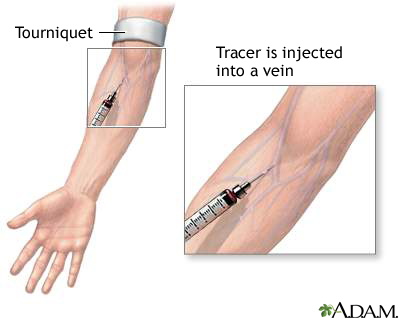Health Library
Gallbladder radionuclide scan
Radionuclide - gallbladder; Gallbladder scan; Biliary scan; Cholescintigraphy; HIDA; Hepatobiliary nuclear imaging scan
Gallbladder radionuclide scan is a test that uses radioactive material to check gallbladder function. It is also used to look for bile duct blockage or leak.
Images


I Would Like to Learn About:
How the Test is Performed
The health care provider will inject a radioactive chemical called a gamma-emitting tracer into a vein. This material collects mostly in the liver. It will then flow with bile into the gallbladder and then through the common bile duct to the duodenum or small intestine.
For the test:
- You lie face up on a table under a scanner called a gamma camera. The scanner detects the rays coming from the tracer. A computer displays images of where the tracer is found in the organs.
- Images are taken every 5 to 15 minutes. Most of the time, the test takes about 1 hour. At times, it can take up to 4 hours.
If the provider cannot see the gallbladder after certain amount of time, you may be given a small amount of morphine. This can help the radioactive material get into the gallbladder. The morphine may cause you to feel tired after the exam.
In some cases, you may be given a medicine during this test to see how well your gallbladder squeezes (contracts). The medicine may be injected into the vein. Otherwise, you may be asked to drink a high-density drink like Boost which will help your gallbladder contract.
How to Prepare for the Test
You need to eat something within a day of the test. However, you must stop eating or drinking 4 hours before the test starts.
How the Test will Feel
You will feel a sharp prick from the needle when the tracer is injected into the vein. The site may be sore after the injection. There is normally no pain during the scan.
Why the Test is Performed
This test is very good for detecting a sudden infection of the gallbladder or blockage of a bile duct. It is also helpful in determining whether there is a complication of a transplanted liver or a leak after the gallbladder has been surgically removed.
The test can also be used to detect long-term gallbladder problems.
What Abnormal Results Mean
Abnormal results may be due to:
- Abnormal anatomy of the bile system (biliary anomalies)
- Bile duct obstruction
- Bile leaks or abnormal ducts
- Cancer of the hepatobiliary system
- Gallbladder infection (cholecystitis)
- Gallstones
- Infection of the gallbladder, ducts, or liver
- Liver disease
- Transplant complication (after liver transplant)
Risks
There is a small risk to pregnant or nursing mothers. Unless it is absolutely necessary, the scan will be delayed until you are no longer pregnant or nursing.
The amount of radiation is small (less than that of a regular x-ray). It is almost all gone from the body within 1 or 2 days. Your risk from radiation may increase if you have a lot of scans.
Considerations
Most of the time, this test is done only if a person has abdominal pain that may be from gallbladder disease or gallstones. For this reason, some people may need urgent treatment based on the test results.
This test is combined with other imaging (such as CT or ultrasound). After the gallbladder scan, the person may be prepared for surgery, if needed.
Related Information
BileAcute
Acute cholecystitis
Gallstones
Bile duct obstruction
Cyst
Transplant rejection
Liver transplant
Liver disease
Liver cancer - hepatocellular carcinoma
References
Grajo JR. Imaging of the liver. In: Sahani DV, Samir AE, eds. Abdominal Imaging. 2nd ed. Philadelphia, PA: Elsevier; 2017:chap 35.
O'Malley JP, Ziessman HA, Thrall JH. Hepatic, biliary, and splenic scintigraphy. In: O'Malley JP, Ziessman HA, Thrall JH, eds. Nuclear Medicine and Molecular Imaging: The Requisites. 5th ed. Philadelphia, PA: Elsevier; 2021:chap 9.
Wang DQH, Afdhal NH. Gallstone disease. In: Feldman M, Friedman LS, Brandt LJ, eds. Sleisenger and Fordtran's Gastrointestinal and Liver Disease. 11th ed. Philadelphia, PA: Elsevier; 2021:chap 65.
BACK TO TOPReview Date: 1/7/2023
Reviewed By: Jason Levy, MD, FSIR, Northside Radiology Associates, Atlanta, GA. Also reviewed by David C. Dugdale, MD, Medical Director, Brenda Conaway, Editorial Director, and the A.D.A.M. Editorial team.
 | A.D.A.M., Inc. is accredited by URAC, for Health Content Provider (www.urac.org). URAC's accreditation program is an independent audit to verify that A.D.A.M. follows rigorous standards of quality and accountability. A.D.A.M. is among the first to achieve this important distinction for online health information and services. Learn more about A.D.A.M.'s editorial policy, editorial process and privacy policy. A.D.A.M. is also a founding member of Hi-Ethics. This site complies with the HONcode standard for trustworthy health information: verify here. |
The information provided herein should not be used during any medical emergency or for the diagnosis or treatment of any medical condition. A licensed medical professional should be consulted for diagnosis and treatment of any and all medical conditions. Links to other sites are provided for information only -- they do not constitute endorsements of those other sites. No warranty of any kind, either expressed or implied, is made as to the accuracy, reliability, timeliness, or correctness of any translations made by a third-party service of the information provided herein into any other language. © 1997- 2024 A.D.A.M., a business unit of Ebix, Inc. Any duplication or distribution of the information contained herein is strictly prohibited.
